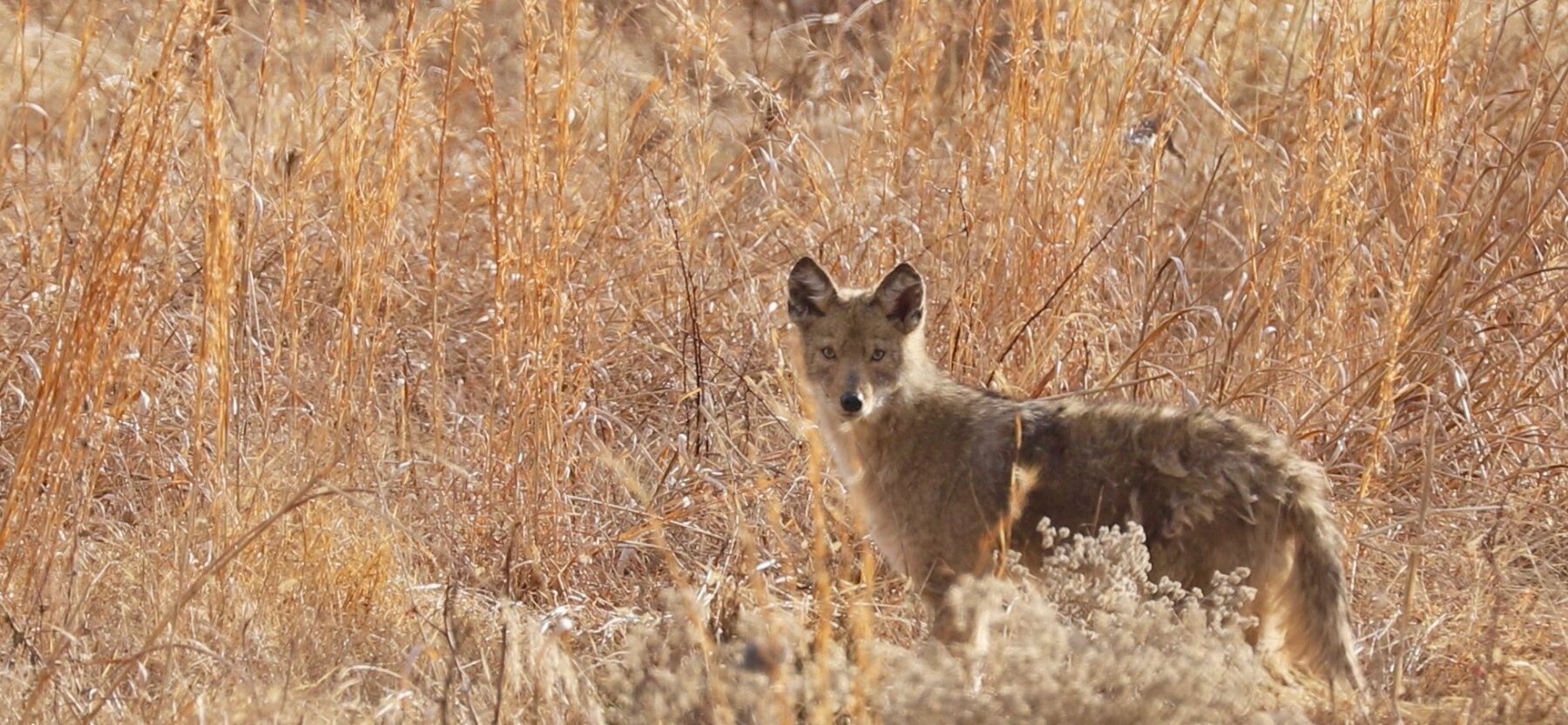Once a symbol of the American west, coyotes are present in every state in the continental US, with Maryland and Delaware being the last areas in the country to be colonized. Coyotes have been present in Montgomery County since the late 1980’s. Numbers remained fairly low, with relatively few sightings throughout the 1990s. Sightings have increased since then indicating, that coyotes are established and part of the local fauna. The following information is provided to help county residents better understand how to live with coyotes.
Natural History
Coyotes are medium-sized members of the dog family resembling a small German Shepard with a long, slender snout and erect pointed ears. Their long, thick fur can make them look larger than they are. Average weight in the east is about 35 pounds, which is about 10 pounds heavier than their midwestern cousins.
It is believed that as coyotes gradually expanded their range east through Canada and the Southern US they occasionally interbred with wolves, resulting in a distinctly larger subspecies which we now call the eastern coyote.
Coyotes Diet
Small mammals, birds, insects, reptiles, fruit, and carrion. Where accessible, garbage, compost, pet food left outdoors birdseed, unprotected small livestock and pets.
Coyote Breeding Details
Breeding season is February – March. Gestation period is 63-65 days. Female has one litter of 4-8 puppies a year, usually in April or May. Family life: Male and female may mate for life. Often associate in loosely organized groups but where food is plentiful, they may form packs similar to wolves with a breeding pair and their offspring from the previous year or two. Coyote packs are less stable than those of wolves. Vocalizations: Coyotes have a number of different calls they use to communicate. Best known are the yips and howls. These long-range calls announce the presence of an animal or group and help group members keep in touch, define territories, attract mates, and avoid face-to-face conflicts.
Coyotes in the Suburbs
It may seem strange to think of coyotes as suburban dwellers, but they are extremely intelligent and adaptable and have taken up residence even within the limits of many large cities across the country. Suburban development with nicely landscaped yards and golf courses, abundant open space and parks, and a mix of agriculture is an ideal habitat for many wildlife species, especially the adaptable coyote. Ensuring that coyotes are viewed as good neighbors has as much to do with our actions as theirs. Coyotes that become too comfortable around humans can quickly become pests. In order to peacefully coexist with coyotes, we are the ones who must learn to adapt.
Here are some things to do and not do in order to keep coyotes wild and to minimize conflicts:
- NEVER feed coyotes or wildlife (other than birds).
- Don’t leave bowls of pet food or water outside at night.
- Keep garbage in sturdy containers with tight fitting lids.
- Keep compost in enclosed bins instead of exposed piles.
- Keep bird feeders out of reach and don’t let seeds accumulate on the ground.
- Keep pets inside at night and watch small dogs while outside, even during daylight hours.
- Keep cats indoors.
- Always walk your dogs on a leash (this is required on parkland and in other locals).
- Spay or neuter your dogs.
- Supervise small children (under 5 years old) at all times.
- Close off crawl spaces under porches and sheds where coyotes could rest and den
- Don’t tolerate coyotes around your yard – chase them off by yelling, throwing sticks, etc.
NOTE: Individuals who are experiencing problems with coyotes or other wildlife species are encouraged to call the toll-free Maryland Wildlife Information line at (877) 463-6497.
What to do when you encounter a coyote on a trail
First, consider yourself lucky to have the opportunity to observe a wild predator in its natural environment. If you have not been detected, take a moment and observe them. Generally, coyotes are shy and will run as soon as they see or smell a human.
In the unusual event that the coyote seems unafraid or even bold, chase it off by waving your hands over your head to appear as large as possible and yelling in a deep voice. If need be, throw sticks or rocks. Most animals will be easily scared off. If a coyote is persistent and threatening in its behavior, walk (don’t run) toward an area with people or back to your car while maintaining eye contact with the animal.
